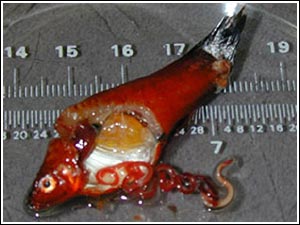

 |
||||||||||||
 |
||||||||||||
| Nematode (Roundworm) Infections in Fish | ||||||
| Page 8 of 11 | Pages: 1 . 2 . 3 . 4 . 5 . 6 . 7 . 8 . 9 . 10 . 11 | |||||
Eustrongylides Species Eustrongylides species can be found within the body cavity, encapsulated on the liver and other organs, but outside the intestinal tract of fish. Eustrongylid nematodes can affect a number of different species, including yellow perch, pumpkin seed, mummichug, guppies, gar, danios, and angelfish. Affected fish typically have bloated abdomens (dropsy), as the nematodes frequently migrate into the body cavity and can be quite large. Eustrongylids are typically very long, coiled, and red (due to presence of hemoglobin), and an infected fish often has more than one nematode in its body cavity ( Figure 11 ). If feeder fish containing Eustrongylides species are fed to other fish, the nematodes can migrate out of the feeder fish and into the muscles or other organs of the fish that just consumed them. After migrating into the muscle, this nematode can cause lesions that look superficially similar to a grub.  Figure 11: Several Eustrongylides nematodes, exhitibing typical coiling (and red coloration when viewed on the EDIS web site or printed in color), from the body cavity of a fish. (Ruler shows measurements in inches on the top and millimeters on the bottom.)
Figure 11: Several Eustrongylides nematodes, exhitibing typical coiling (and red coloration when viewed on the EDIS web site or printed in color), from the body cavity of a fish. (Ruler shows measurements in inches on the top and millimeters on the bottom.)
Eustrongylides species have complex, indirect life cycles. Adult Eustrongylides tubifex and other Eustrongylid nematodes are found in fish-eating birds. The eggs are shed by the birds into ponds, where they develop into a life stage that is consumed by an oligochaete worm, such as the tubifex worm. Within these tubifex worms, the nematodes develop still further into a third larval stage, known as an "L3", which is the life stage of the Eustrongylides group that can infect fish when eaten. Once the tubifex worm containing the L3 stages is eaten by a fish and digested, the nematodes migrate (within the fish) into the body cavity and, frequently, over the external surface of internal organs such as the liver. Some recent studies, however, suggest that Eustrongylides ignotus, commonly found in mosquitofish and which is a close relative of Eustrongylides tubifex, may be able to complete its life cycle without the need for a tubifex worm (D. Coyner, University of Florida, unpublished data; D. Forrester, University of Florida, personal comm.). The eggs of all Eustrongylides species are very tough and can easily survive for some time in fish ponds. At about 77°F, it can take anywhere from three months to four and one-half months from the time the bird infects the pond with Eustrongylides' eggs until the time fish become infected. This means that, after sterilization of ponds, if fish-eating birds do infect the ponds with Eustrongylides eggs, the producer may not see a problem until harvesting the fish, 3-4 months later, as this is approximately the time required for the eggs to hatch and become the L3 stage which infects the fish. After this 3-4 month period, fish raised in ponds with a population of fish-eating birds have an even greater chance of becoming infected as the number of nematodes increase over time. Diagnosis As Eustrongylides species infect areas outside the gastrointestinal tracts of fish, necropsy of a small group of affected fish is the only sure method to identify them. During necropsy Eustrongylides species, such as E. tubifex, are easily identified from their location in the fish (encysted in mesenteries of the body cavity or in muscle), their red coloration, and their relatively long bodies (11-83 mm); however, there are other nematodes that may appear similar, so positive identification will require examination by an expert. Treatment Other than mechanical removal, there is no effective treatment for these nematodes due to the location of the larvae within the coelomic cavity or in the muscle. Culling affected fish is recommended. Prevention Removal of the final host (fish-eating birds) or any intermediate hosts (tubificid worms or other oligochaetes) will help reduce the infection rate. Sanitation of ponds or tanks will help remove any intermediate hosts. Sanitation of ponds at the very minimum of once or twice a year is recommended. more ... |
 |
|||||
| About Us :: Message Board :: Chat | |||||
| Library :: Photo Gallery :: Links & Resources :: Breeders & Sponsors :: Merchandise | |||||
| Website designed by: EthanCote.com | © 2001-2004, SimplyDiscus.com. All Rights Reserved. | ||||